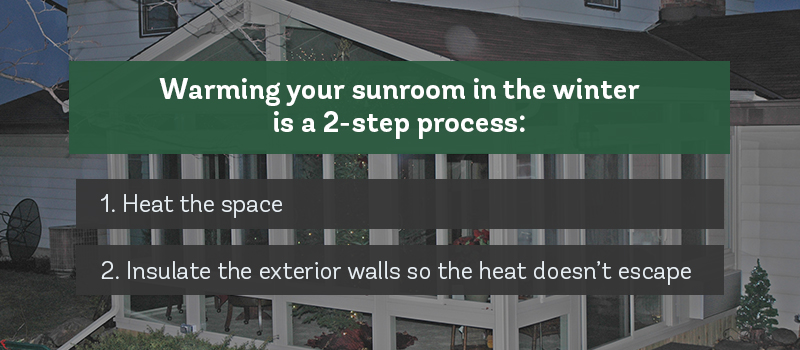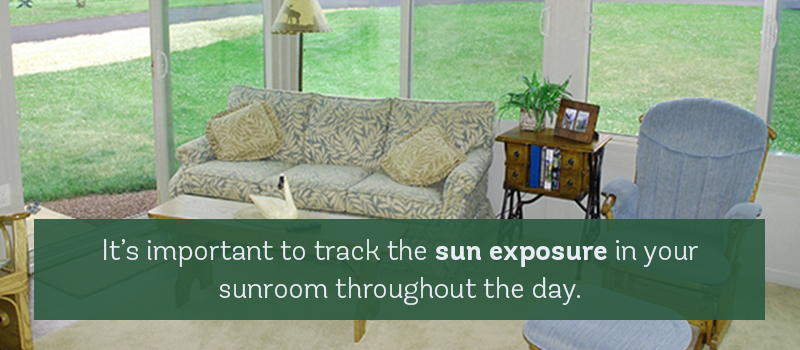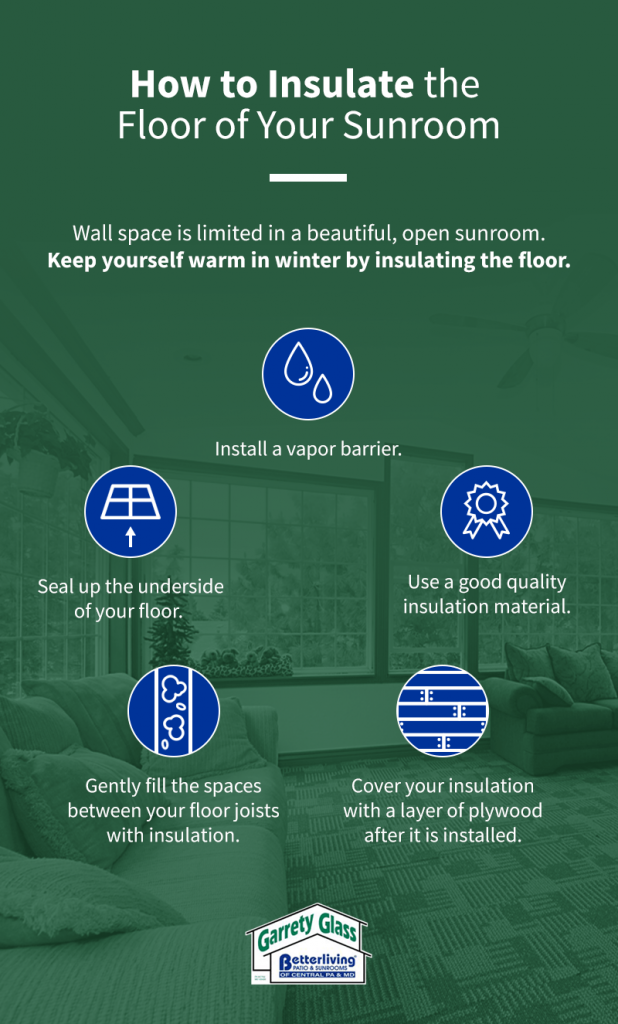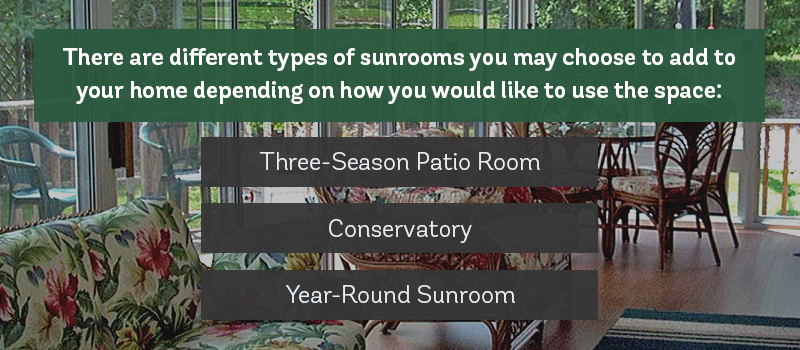Last Updated 05/28/2024

Sunrooms are a great way to expand the living space in your home and extend it toward the outdoors. They can provide a space that’s free of bugs and other pests so you can enjoy the summer sun in peace. They protect you from any wind, rain or other weather conditions that might hamper an outdoor soiree as well. Additionally, if you have beautiful vistas around your property, a sunroom also helps you take advantage of the views.
Here in the Northeast, the seasons and temperatures change drastically throughout the year, so a space that is comfortable in summer can be very cold in winter. However, with the right construction and insulation, a sunroom can be comfortable to relax in throughout the year.
Most sunrooms are traditionally designed to be used in the summer when the sun is brightest and the weather is warm. It is sad when the summer season is over, though, and you have to stop using your sunroom. Is it possible to make your sunroom a space you can enjoy all year? Fortunately, the answer is yes!
How to Keep A Sunroom Warm in the Winter

Warming your sunroom in the winter is a two-step process. First, you have to heat the space, and second, you must insulate the room to keep the heat inside. Proper insulation will also help cut down on your heating costs.
To keep your sunroom warm, here are some of the best ways to improve your space’s heat retention:
- Use weather-stripping: Prevent your warm air from leaking out around the window frames by installing weather-stripping around the windows. You can also use a clear caulk to seal the areas between window frames and the wall or between two window frames that butt together.
- Add clear plastic insulation to window surfaces: A layer of clear plastic will help prevent the warm air from escaping through the windows in your sunroom. Plastic does not have the same R-value as a solid material insulation, but it will improve the energy efficiency of your windows, especially if they are single-pane glass.
- Apply window tinting: Window tinting allows sunlight to enter a space while helping prevent heat from leaving the room. The tint may slightly affect your view through the windows, but the temperature difference may be worth the trade-off depending on your preferences.
- Install a ceiling fan: A ceiling fan will not create heat, but when you reverse the spinning direction, the fan can help you take advantage of any heat that is already in the room. By slowly circulating the air in your sunroom, the fan pushes warm air that rises back down into the living space in your room where you can feel it.
- Cover the windows with insulated drapes: Insulated fabric will help hold the warm air in your sunroom. During the day when the sun is shining, you can open the drapes to capture the radiant heating. When the sun goes down, close the drapes to maintain that warm solar gain.
How to Heat a Sunroom
You can heat a sunroom with solar energy in the winter depending on the positioning of the room. South-facing sunrooms with all-day sun exposure are most likely to have more comfortable temperatures throughout the winter.
If your sunroom is north facing or if you need additional heat to make the space more comfortable, you can add heat to your sunroom in the cold winter by:
- Using heat from your home: You may be able to heat your sunroom by simply opening the door to your house and letting the heat flow out there. Warm air will naturally move toward the cooler space until the temperature balances out.
- Installing heat sources: When constructing your sunroom, you may want to include a heating fixture such as a pellet stove, solar heater, baseboard heater or radiant floor heating system to help keep the room warm. A reliable heat source can be a valuable investment if you plan to be in your sunroom a lot during the winter.
- Bringing in portable heaters: Portable space heaters or electric fireplaces can be an easy way to add heat to your sunroom whenever you plan to use the space. Follow the manufacturer’s directions to safely heat your sunroom.
How to Keep a Sunroom Cool in the Summer

Summer is the perfect time to enjoy your sunroom with its beautiful big windows and all-day sun exposure. After all, the idea of a sunroom is to take advantage of the good summer weather and to enjoy the outdoors without rain or bugs.
One problem that comes with sunny weather, though, is summer heat. Sitting behind those big windows in your sunroom is comfortable until the solar gain makes the room unbearably hot. That heat can even invade your house and force your air-conditioning to run more than usual.
Cooling a hot sunroom can be a challenge, but here are some ideas to work with:
- Increase airflow in your sunroom will help cool it in the summer: You will need some type of ventilation openings high in the room, so when the heat rises, it can escape. Depending on the design of your sunroom, you may need ventilation fans to help hot air leave your space. You can also place fans near the floor to increase airflow through your living space. They will blow the hot air up toward the vents and allow it to escape. Fans will also keep air moving so heat does not linger in the living space.
- Use window tinting to block solar gain: The windows of your sunroom can be tinted to keep some of the heat from the sun out of the room. Window tinting will also block some of the light, but proportionally more heat will be blocked. Insulated windows can have the same effect, but you may not want to replace the windows in your sunroom after it is built. This is something to consider when your sunroom is still in the construction phase.
- Install blinds to block out the heat from the sun: There are a number of different types of blinds you can get for your sunroom. Some are hung on the insides of the windows, and some are sandwiched between the panes of glass. The latter would have to be considered when the windows are being purchased and installed. Window blinds give you more options than other types of window coverings. Blinds can be partially open or tilted up or down to deflect the solar radiation in a different direction.

It is important to track the sun exposure in your sunroom throughout the day. Knowing where the hot spots are can help you mitigate the problem. If your sunroom gets full morning sun, for example, that is when you want to employ some measure to block some of it out. You may be able to close the blinds in the morning and then open them later to enjoy the rest of the day in comfort in your sunroom.
If keeping your sunroom cool in the summer is a big problem, you could even install insulated drapes or blackout shades. They will completely block the sunlight and the view from the sunroom, but if you get intense sunlight during one part of the day, it could be worth giving up the view for a few hours to cut back on the heat.
How to Insulate a Sunroom
A significant factor in maintaining a comfortable sunroom temperature is insulating the space so the outdoor weather has less of an effect. Insulation separates you from outside air temperature so you can enjoy greater comfort within your living space.
Your sunroom’s energy efficiency will be affected by the quality of insulation, so it’s helpful to insulate the space properly. If your sunroom was built without insulation, whether it used to be an open porch for summer use or simply lacked appropriate insulation, you may need to make adjustments to improve your sunroom’s ability to maintain a comfortable temperature.

1. Choose Insulated Windows
When you are spending time in your sunroom, you want to see the outdoors — not necessarily feel it. Selecting insulated glass can help you gain beautiful views while ensuring your space stays a comfortable temperature year round.
2. Insulate the Walls
A sunroom has very little solid wall space, so there are few opportunities to insulate your sunroom’s walls through traditional ways. It is a good idea to approach each section one at a time, using some type of solid insulation in the walls like a fiberglass or foam with a good R-value. You may not have much wall space in your sunroom, but it should all be insulated to help maintain a comfortable living temperature.
3. Insulate the Flooring
Pay attention to the floor when insulating your sunroom. A lot of energy can escape through the floor, especially when you have a raised sunroom. The floor provides a solid surface where you can hide some good insulating material. Here are some steps you can take to insulate the floor of your sunroom:
- Install a vapor barrier to keep moisture and condensation off your insulation, floor joists and the bottom of your flooring material.
- Seal up the underside of your floor from the outside with some wire mesh to contain the insulation and keep small critters from nesting into it.
- Use a good quality insulation material. Check the R-value to be sure you are getting enough insulating value.
- Gently fill the spaces between your floor joists with insulation. Never pack the insulation in tight between the joists. Insulation needs to trap air in it to work right. If you pack the insulation in too densely, it will not work.
- When working with fiber insulation, always wear gloves and a mask. The fibers might cause irritation if you breathe them in.
- Cover your insulation with a layer of plywood after it is installed. The plywood will help hold the insulation in place and provide an extra layer of protection against the elements. Then, you can cover the plywood with your flooring of choice to complete the space.
When insulating under a raised sunroom, you will still gently fill spaces between joists with foam board. You can use strapping to hold the foam in place, then cover the foam boards and exposed wood with spray foam or foam panels to help block air and fluctuating temperatures. Enclose the area with a solid surface, such as rigid foam or pressure-treated plywood, along with durable caulking.
Windows and Heat Loss in Your Sunroom
One of the biggest energy loss factors of your sunroom may be the windows. You want windows that fit securely so air is not transferred around the frames. Heat can come in during the summer and go out in the winter through tiny gaps between the window frame and the wall.
The glass in your windows can present an insulating challenge. If your windows are old, they may only contain one pane of glass with no insulating factor. However, upgrading the windows could have a big impact on the energy efficiency of your sunroom. New windows can be made with multiple panes of glass that contain clear insulating material like gas to block heat transfer.
Installing new insulated windows in your sunroom could be a do-it-yourself project, but since most sunroom windows are often special order, you probably won’t be able to return them easily if your measurements are off. For that reason, and to ensure you have the best insulating components possible, it can be beneficial to work with a professional.
For help with all your sunroom replacement window needs, contact Garrety Glass. Our professional staff can help you select the right windows for the job and get the precise measurements. If you like, we can even install the windows for you to ensure the best fit and insulating value for your sunroom.
When we remove the old windows, we’ll be sure to clean up the openings so there are no obstructions for the new installation. We’ll level your window before securing it in the opening and caulk around the window to fill any gaps and keep air from escaping.
A Comfortable Sunroom All Year Round
The best way to control the temperature in your sunroom is to consider your sun exposure when you build the sunroom and adapt your selection to how you want to use the room. A year-round sunroom can be created with the right insulating factors for the sun exposure in your location.

There are different types of sunrooms you may choose to add to your home depending on how you would like to use the space:
- Three-Season Patio Room — These are a very popular option for extending your outdoor living options beyond just summer. Rain, wind and bugs will not interfere with your enjoyment of this outdoor entertaining space. A three-season patio room can be an economical addition to your home that pays you back with more relaxing and hassle-free outdoor living.
- Conservatory — A conservatory can be a serene, elegant and relaxing space for your home. In addition to being a sunroom you can enjoy in all seasons, you might also use it as a beautiful greenhouse space or a Victorian garden room.
- Year-Round Sunroom — This add-on feature to your house can be built to handle all of the necessary heating and cooling requirements of an indoor space with the sun exposure of a porch and protection from rain and bugs.

The professionals at Garrety Glass can build or remodel a sunroom that fits your home, your family and our weather conditions here in the Northeast. From Central Pennsylvania to Northern Maryland, we help homeowners enhance their view and living enjoyment while conserving energy usage and increasing comfort.
When your sunroom is designed for year-round living, you have no concerns about cooling it in summer or heating it in winter. Hiring a professional to install or update your sunroom can ensure you achieve your desired results. The weather in the Northeast can be harsh, so having a space where you can relax and entertain without being affected by the climate is ideal. Contact Garrety Glass for a free consultation.